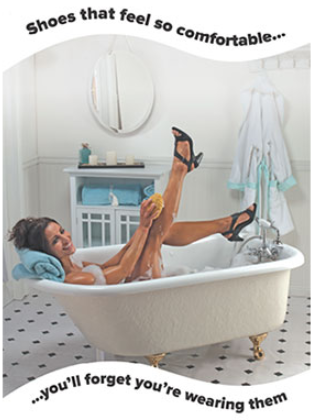Especially in people on their feet all day
If you’re a nurse, teacher, shop assistant, or tradesperson who’s on your feet from morning to night, you’re not alone in feeling that deep, nagging heel pain by the end of the day.
At Essex Footcare, we see this kind of pain every single week in our Billericay, Basildon, and Romford clinics. It’s one of the most common reasons people come to see a podiatrist or chiropodist, and the good news is, with the right care, it can be treated and prevented.

👣 Why heel pain happens
Your heel takes on the full force of your body weight every step you take. Over time, standing or walking for long hours, especially on hard floors or in unsupportive shoes, puts strain on the plantar fascia, the strong band of tissue that supports your arch.
This can lead to tiny tears and inflammation known as plantar fasciitis, one of the most common causes of heel pain where pain is often worst first thing in the morning as you take the first few steps. It hurts!
But sometimes, the pain can also come from:
- A tight Achilles tendon pulling on the heel bone
- Poor footwear or arches that flatten too much
- Uneven posture or gait/ walking pattern that shifts pressure to the wrong places
- Or simply the effects of fatigue and overuse
Why certain jobs make it worse
Some professions make you more likely to suffer from heel pain because of the constant strain and lack of recovery time.
If you spend hours on your feet every day; teaching, nursing, working in retail, hairdressing, or construction, your feet rarely get the break they need. Hard floors, safety boots can make things even worse.
Your body adapts silently over time, until one day, the pain stops you in your tracks.
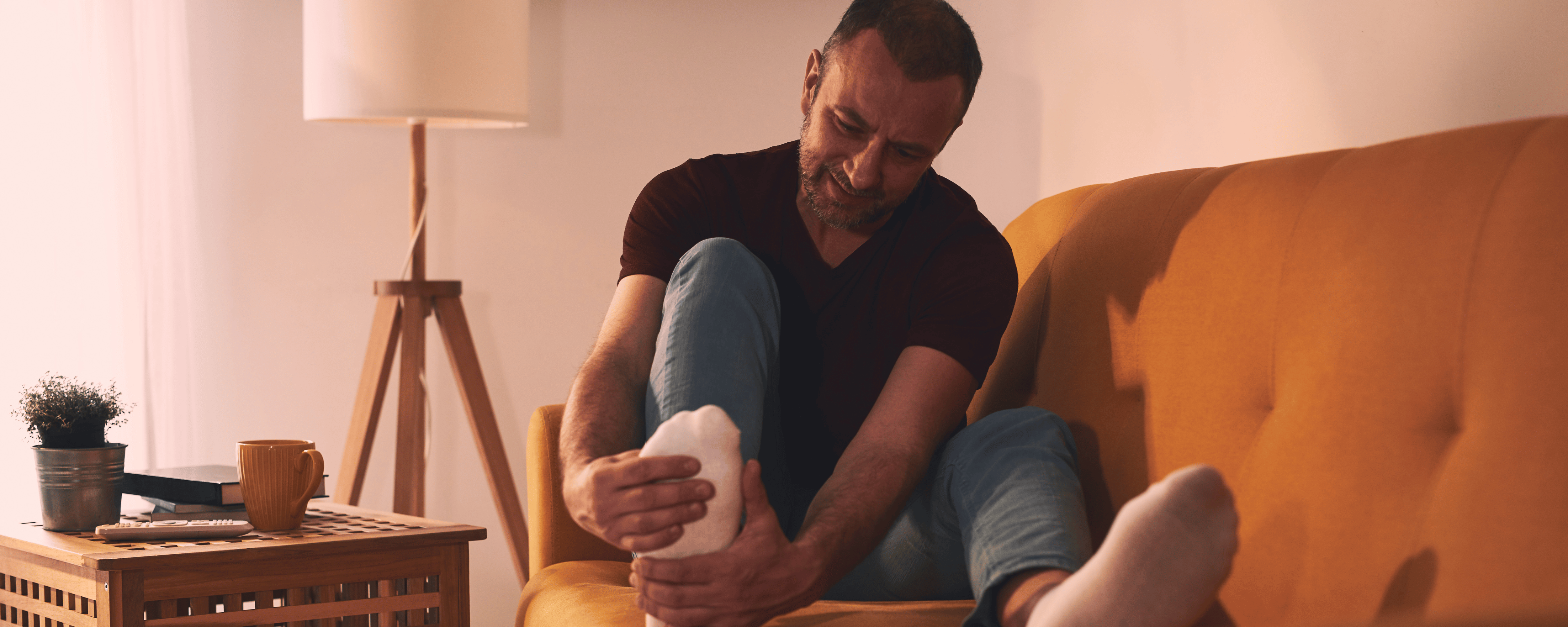
The problem with “Just coping”
Many of our patients tell us they’ve “just lived with it” for months or even years, trying different insoles, rolling their foot on a tennis ball, or taking painkillers.
But without understanding what’s really causing the problem, the pain often returns or even gets worse.
That’s why we take the time to look deeper. Our approach combines hands-on assessment with advanced gait and motion scanning to understand how your foot moves, balances, and carries your weight, right down to 0.1mm accuracy.
Some tips to help you:
If your heel pain feels sharp first thing in the morning or after sitting for a while, it could be plantar fasciitis, inflammation of the thick ligament that supports your arch.
Here are a few small things that can help ease discomfort at home:
👣 Support your feet: Wear shoes that are not sloppy or too big — even indoors. Walking barefoot on hard floors can make symptoms worse.
🧊 Reduce inflammation: Rolling your foot gently over a cold can or frozen water bottle for 5–10 minutes can calm irritation but this can only be a short-term fix to relieve symptoms over using ice can actually limit the healing process.
🧘♀️ Do not carry out deep stretching without guidance however gentle stretches can ease tightness. Try light calf and foot stretches morning and evening — this keeps the ligament flexible and reduces tension.
These steps can bring short-term comfort, but they don’t solve the underlying cause. Everyone’s feet, posture and gait are unique, which means the reasons for heel pain often are too.
At Essex Footcare, we look beyond symptoms to understand why your plantar fascia is under strain. Through gait scanning, footwear assessment, and custom Phits orthoses, we design a plan that’s as individual as your footprint, helping you heal properly, not just temporarily.

A clear plan, not just a quick fix
Once we understand what’s happening, we’ll create a custom plan to relieve pain and stop it coming back.
That may include:
- Gait analysis and posture assessment
- Footwear review and advice
- A tailored home rehab programme
- Custom 3D-printed Phits orthotics – the same technology trusted by Sir Mo Farah and other elite athletes
- And if needed, shockwave therapy to help chronic heel pain heal faster
We know there’s no magic wand, but with the right plan, we help people get back to walking, working, and living comfortably again.
💙 Why choose Essex Footcare?
With over 35 years of experience, our team has cared for thousands of people with heel and foot pain.
We’re not just about feet, we’re about helping you move freely, stay active, and enjoy life again.
At our friendly clinics in Billericay, Basildon, and Romford, you’ll find the right mix of technology, experience, and genuine care.
🌿 Ready to take the first step?
If heel pain is stopping you from doing what you love, let’s find out what’s really going on and start your recovery today.
📍 Visit us at Essex Footcare
👉 Book your journey to recovery, call your nearest clinic in Billericay 01277 659200, Basildon 01268 553653, or Romford 01708 728498
Is Foot Pain Stopping You in Your Tracks?
Foot pain can have a dramatic impact on your life, affecting everything from your daily work routine to your favourite activities. Whether you stand for long hours at work or enjoy walking and running as hobbies, persistent foot pain can transform these activities from enjoyable to agonising experiences.
Consider the complexity of your feet: each foot contains 26 bones, 33 joints, and over 100 ligaments, tendons, and muscles. With so many intricate components working together, there are countless potential causes of foot pain. This is why accurate diagnosis and personalised treatment are essential for effective relief.
What is Footscan Gait Analysis?
We've invested in cutting-edge gait and motion foot scanning technology to provide our patients with the most accurate assessment possible. Our high-tech Footscan system captures your unique postural and walking data in extraordinary detail, enabling us to deliver the best possible solution for your foot pain and get you back to doing all the things you love.
Footscan represents the gold standard in biomechanical assessment technology. This innovative system has been utilised in more than 3,000 scientific studies and is trusted by state-of-the-art movement laboratories, the British Armed Forces, and elite sports teams worldwide for over three decades. The combination of robust, clinically accepted hardware and software provides comprehensive analysis of gait, movement, pressure, and more.
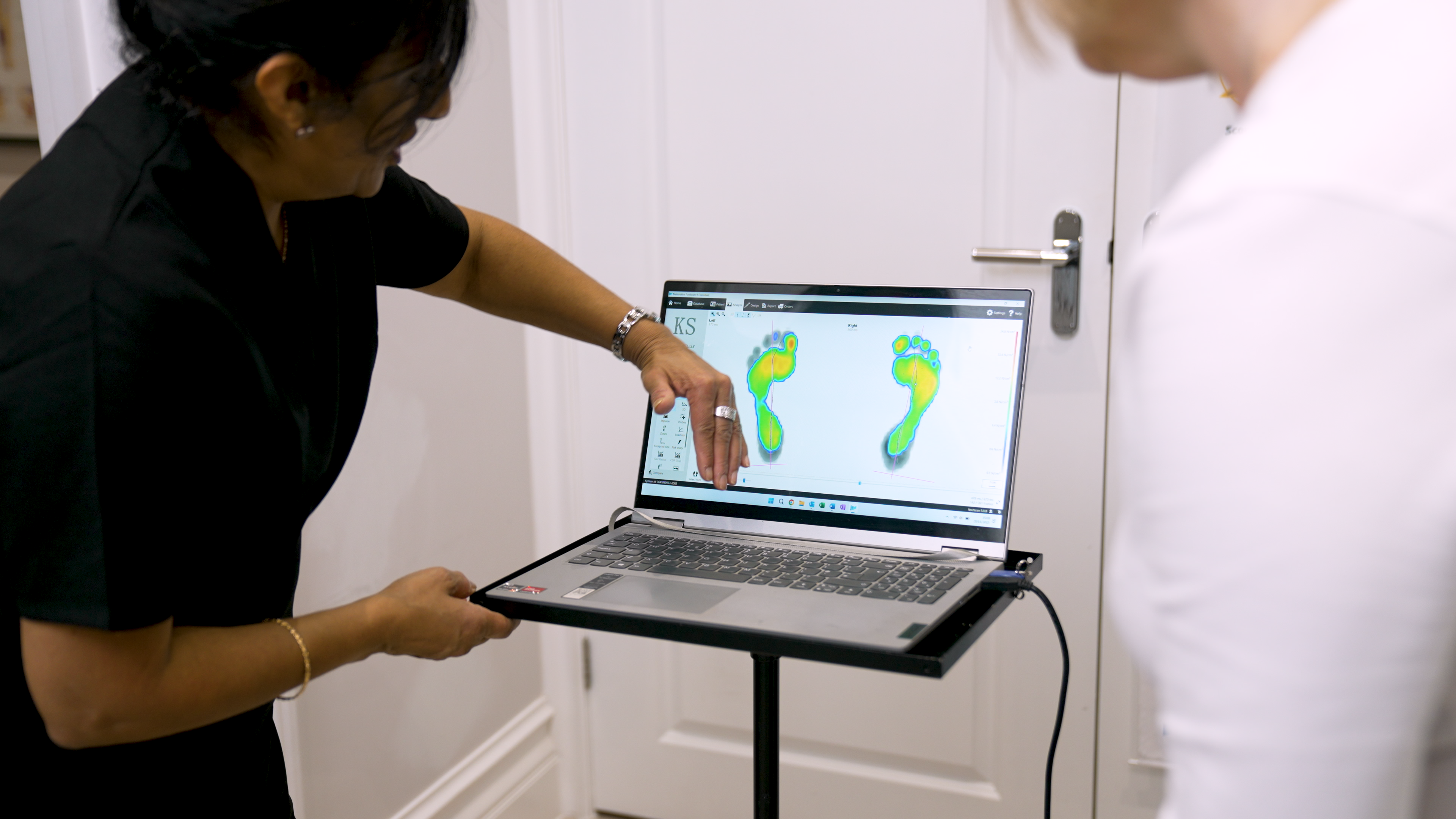
How can Footscan help you?
Footscan Gait Analysis is particularly beneficial if you:
-
Struggle with heel pain, knee issues, or lower back discomfort
-
Feel unstable, off-balance, or tire quickly when walking
-
Are recovering from injury or planning to return to sport
-
Want to prevent issues before they develop
-
Are considering orthotics and want them tailored to your actual gait data
What to expect during your Footscan appointment
Your appointment begins with a comprehensive consultation where your podiatrist will:
-
Discuss your symptoms in detail to understand your specific concerns
-
Learn about your lifestyle, activity levels, and personal goals
-
Analyse your current footwear to identify potential contributing factors
-
Conduct a thorough assessment of your feet and lower limbs
The heart of your appointment involves our digital foot scanning technology:
-
You'll walk over our specialised pressure plate several times
-
The system captures detailed data about your foot mechanics and movement patterns
-
We analyse your unique foot scan data while you're both standing and walking.
-
Your results appear instantly on-screen for immediate review
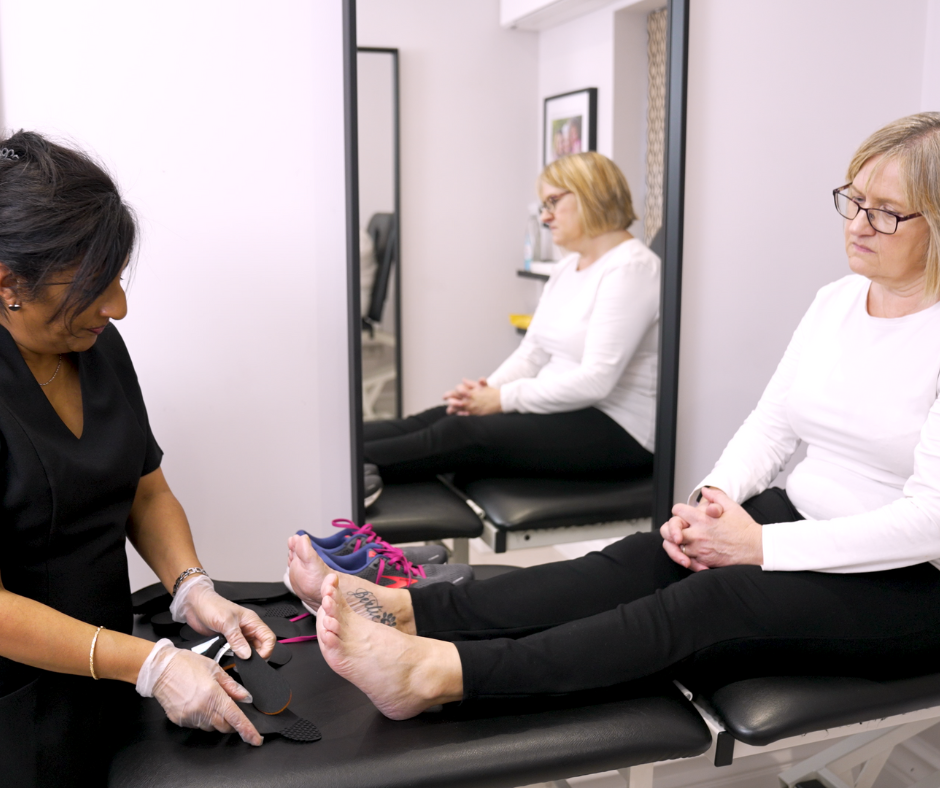
One of our skilled podiatrists will guide you through the findings, explaining what the data means and helping you understand the implications for your foot health. This detailed analysis forms the foundation of your personalised treatment plan.
Based on your scan results and consultation, you may be advised that you need custom orthotics or insoles. If required, we can design bespoke orthotics using dynamic, state-of-the-art 3D printing technology, creating the world's first high-tech 3D printed insoles specifically tailored to your feet.
Whether your treatment involves rehabilitation exercises, strength work, or custom orthotics, you'll leave with a comprehensive plan designed to address the root cause of your pain, not just the symptoms.
What to wear and bring to your Footscan appointment
To ensure we get the most accurate assessment possible, please come prepared with:
-
Comfortable pair of shorts (or bring them along if the weather is cold)
-
Clothing that allows easy access to your feet and lower legs
-
A range of your everyday and/or sporting footwear
-
Any existing insoles or orthoses you currently use
-
Reports from previous x-rays, scans, or imaging (if available, though not essential)
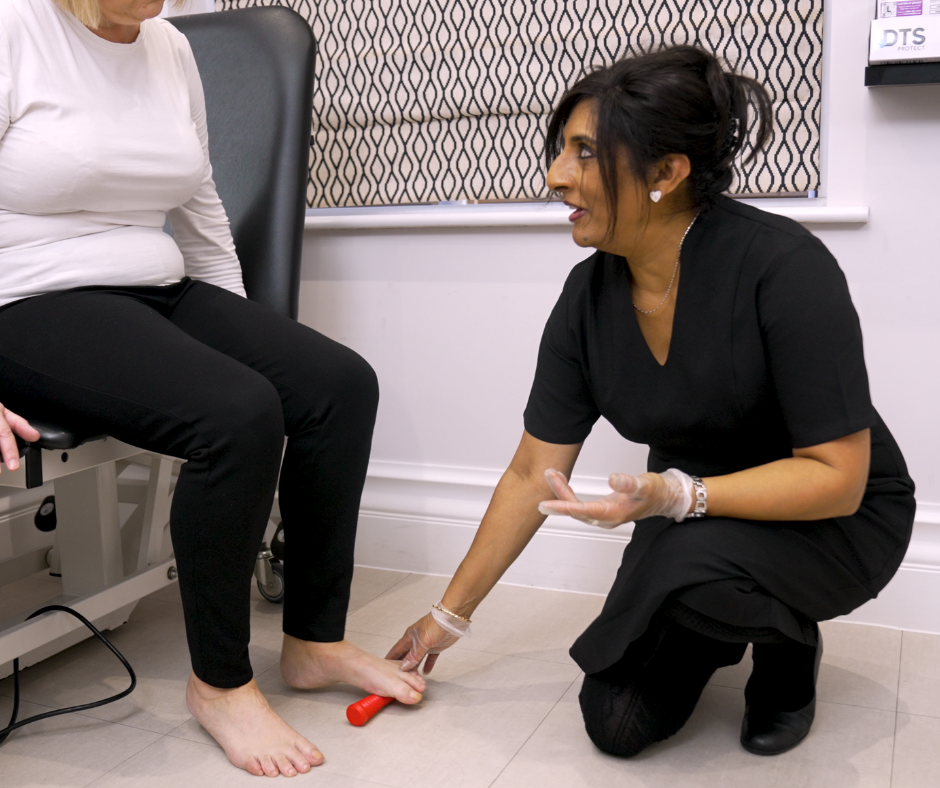
Our mission is simple: to relieve your pain and enable you to continue doing all the things you love. Whether that's walking your dog, training for a marathon, or playing with your grandchildren, our Footscan technology and expert analysis can help you return to an active, pain-free lifestyle.
Innovation, accuracy, and reliability are critical components of effective healthcare. With Footscan technology, you can trust that you're receiving the most advanced biomechanical assessment available, backed by decades of research and real-world application.
Don't let foot pain limit your life any longer. Contact us today to schedule your Footscan Gait Analysis appointment and take the first step toward lasting relief and improved mobility.
Tips For Beautiful Feet
Your feet are often the most neglected part of your body, yet they bear the brunt of daily activities and deserve just as much attention as your face or hands. Beautiful feet are not only aesthetically pleasing but also a sign of good health. Here are some tips to help you achieve and maintain beautiful, healthy feet.
1. Regular Cleansing
Keeping your feet clean is the first step to beautiful feet. Wash your feet daily with warm water and a mild soap. Pay special attention to the areas between your toes. After washing, make sure to dry your feet thoroughly to prevent fungal infections.
2. Exfoliation
Exfoliating your feet helps to remove dead skin cells and prevent the build-up of hard, rough patches. Use a pumice stone, foot scrub, or an exfoliating foot mask at least once a week. Focus on areas that tend to be rough, such as the heels and balls of your feet. If heel begin to crack they can become painful very quickly.
3. Moisturise Daily
Dry skin can make your feet look dull and unattractive. To keep them soft and smooth, moisturise your feet daily. Opt for a rich foot cream or lotion that contains ingredients like urea, shea butter, or glycerin. Apply the moisturiser after your evening shower or before bed for the best results.
4. Regular Trimming and Filing
Keep your toenails trimmed and filed to avoid ingrown nails and to maintain a neat appearance. Trim your nails straight across and use a nail file to smooth the edges. Be careful not to cut them too short, as this can lead to discomfort, infections and ingrown toe nails.
5. Cuticle Care
Just like the nails on your hands, the cuticles on your toes need care too. Gently push back your cuticles after a shower when they are soft. Avoid cutting them, as this can cause infections. Instead, use a cuticle remover or cream to keep them tidy.
6. Foot Soaks
Indulge your feet in a relaxing foot soak once a week. Soak your feet in warm water mixed with Epsom salt, essential oils, or a foot soak solution for about 15-20 minutes. This helps to soothe tired feet, soften the skin, and reduce swelling.
7. Wear Proper Footwear
The right footwear is essential for maintaining beautiful feet. Wear shoes that fit well and provide adequate support. Avoid tight shoes that can cause blisters, calluses, and other foot problems. When at home, let your feet breathe by wearing open-toed slippers or going barefoot. Take a read of our advice on different types of shoes.

8. Use Sunscreen
Your feet are exposed to the sun just like any other part of your body, and they can get sunburned too. When you’re out and about in open footwear, make sure to apply sunscreen to your feet to protect them from harmful UV rays.
9. Stay Hydrated
Hydration is key to maintaining healthy skin, including the skin on your feet. Drink plenty of water throughout the day to keep your skin hydrated from the inside out. This helps to prevent dryness and promotes overall skin health.
10. Treat Problems Promptly
If you notice any foot problems, such as fungal infections, warts, or persistent dryness and cracking, address them promptly. Over-the-counter treatments are available for many common foot issues, but don’t hesitate to consult a podiatrist if the problem persists or worsens.
11. Pamper with a Pedicure
Regular pedicures can keep your feet looking their best. Whether you do it yourself or visit a salon, a pedicure helps to maintain nail health, exfoliate dead skin, and keep your feet moisturised. Make sure to follow good hygiene practices to avoid infections.
12. Foot Exercises
Keep your feet strong and flexible by incorporating foot exercises into your routine. Simple exercises like toe curls, arch lifts, and ankle rotations can improve circulation and prevent foot fatigue. Stretching your feet and toes regularly can also help maintain their flexibility.

Beautiful feet require consistent care and attention. By incorporating these tips into your daily and weekly routines, you can keep your feet looking and feeling their best. Remember, healthy feet are the foundation of your overall well-being, so treat them with the care they deserve. Your feet will thank you!
Book your appointment with us to keep your feel healthy and beautiful.
Have you ever felt overwhelmed by the multitude of shoe options out there?
From the office to the gym, and even cosy nights at home, finding the perfect pair can be daunting.
Fear not!
We've curated a comprehensive guide, drawing insights from Essex Foot Care's three clinics, to help you make informed decisions for happy, healthy feet.
Types of Shoes
Walking Shoes
For those who enjoy brisk walks or have an active lifestyle, investing in proper walking shoes is crucial. We suggest:
- Arch Support: Look for shoes that provide adequate arch support to prevent discomfort and overpronation.
- Cushioning: Opt for shoes with ample cushioning to absorb shock and reduce impact on your joints, especially during long walks.
- Breathable Materials: Shoes made of breathable materials help keep your feet cool and dry, preventing potential issues like blisters.
High Heels
While high heels can elevate any outfit, they may not always be kind to your feet.
We would encourage you to think about:
Heel Height: Consider opting for lower heels to minimize strain on the balls of your feet and lower back.
Platform Soles: Shoes with platform soles can provide some elevation without increasing the height of the heel.
Cushioned Insoles: Look for heels with cushioned insoles to add comfort and reduce pressure on the soles of your feet.
Children's Shoes
Properly fitting shoes are vital for children's growing feet. Essex Foot Care recommends:
-
Room to Grow: Ensure there's ample room (about a thumb's width) between the longest toe and the end of the shoe to accommodate growth.
-
Flexible Soles: Children's shoes with flexible soles allow natural foot movement, aiding in proper development.
-
Breathable Materials: Shoes made from breathable materials help prevent sweating and discomfort.
Slippers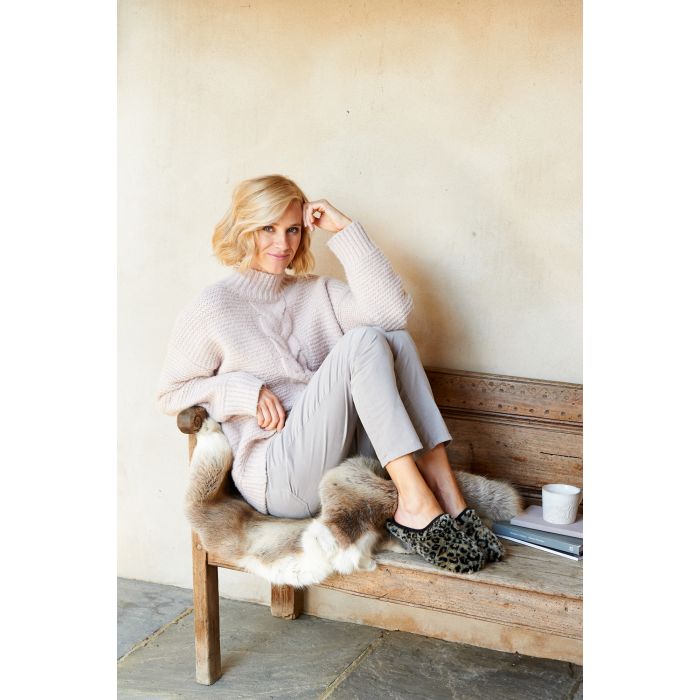
Even your indoor footwear matters for foot health. Think about:
-
Support: Look for slippers with arch support to provide stability and comfort, especially if you wear them for extended periods.
-
Non-Slip Soles: Slippers with non-slip soles reduce the risk of accidents, particularly on smooth surfaces.
-
Warmth and Comfort: Choose slippers made from materials like wool or fleece for warmth and cosiness during colder months.
-
Well-fitted: It’s important to consider that worn, loose slippers are a fall hazard and could cause trips or falls in the home
Photo from Widerfitshoes.co.uk
Choosing the Best Shoes
When it comes to selecting shoes for any occasion, we’d encourage you to consider the following factors:
-
Fit: Shoes should feel comfortable from the moment you try them on. If they feel too tight or too loose, they're likely not the right fit.
-
Purpose: Match the shoe to the activity. Athletic shoes are designed for sports, while dress shoes are ideal for formal events.
-
Quality: Investing in well-made shoes ensures durability and proper foot support, reducing the risk of foot problems.
Shoe Fitting Guide
Properly fitting shoes are essential to foot health. Essex Foot Care offers these fitting tips:
-
Measure Both Feet: Feet can vary in size, so measure both and go with the larger size.
-
Try Shoes Later in the Day: Feet tend to swell throughout the day, so try shoes on in the afternoon or evening for a more accurate fit.
-
Wiggle Room: There should be about a half-inch of space between the longest toe and the end of the shoe to prevent cramping.
-
Walk Around: Take a few steps in the shoes to ensure they don't slip or rub uncomfortably.
Remember, your shoes should look good and support your feet throughout the day. Whether exploring Essex or enjoying a quiet night in, the right shoes can make all the difference.
Our experts are happy to advise what you must look out for when investing in footwear. We are here to help and encourage you to find the perfect fit for your lifestyle and foot health needs. Get in touch if you have any questions.
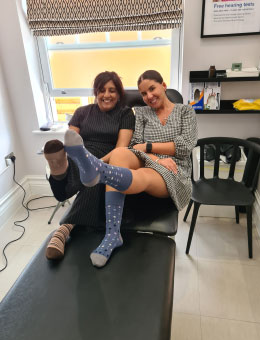 Are You Wearing the Right Socks for Your Feet?
Are You Wearing the Right Socks for Your Feet?
That's the question I asked a patient recently while treating her painful cracked heel and athlete's foot during her podiatry treatment.
She grinned and told me that she had no clue about socks other than receiving Christmas socks or buying cheap multipack socks when she ends up with an assortment of odd socks (where do socks disappear !?).
Socks are more than just a covering for your feet; they play a crucial role in foot health, comfort, temperature regulation, support, cushioning, and prevention of foot problems. Here's a comprehensive guide on how to improve your sock life and, consequently, your foot health.
Choosing the Right Material
Socks can be made from various materials, and matching the material to the activity can significantly enhance foot health and comfort.
- Bamboo and Cotton: These are excellent all-round materials for everyday wear, providing comfort and breathability.
- Merino Wool and Cashmere: Ideal for colder weather, these materials offer superior warmth and softness.
- Cotton, Polyester, Nylon, and Spandex Mix: These are perfect for hiking, sports, and athletic activities. They improve comfort, moisture-wicking, temperature control, and stretchability.
-
Cushioned Socks: Socks with additional cushioning underfoot are great for high-impact activities and can help prevent blisters.
Size Matters
Wearing socks that fit well is crucial. If they're too tight, they can inhibit free movement, cause the toes to claw, restrict circulation, and generally feel uncomfortable. On the other hand, socks that are too big can feel bulky and lumpy, causing discomfort and potential foot issues.
Change Daily
This may seem obvious, but not everyone follows it. Fungal infections, sweat, and dirt can all accumulate on socks, so changing them daily is essential to prevent foot problems.
Follow Washing and Drying Instructions
Adhering to the washing and drying instructions on your socks can increase their lifespan and maintain their material qualities. This will help keep your socks effective and comfortable for longer.
Throw Away Socks with Holes
It's surprising how many patients have foot problems due to wearing socks with holes. These can cut into the skin and cause discomfort or even injury. Always discard socks that are worn out or damaged.
Who would think that there is so much to say about the humble sock, the unsung hero of feet! Proper sock selection and maintenance can make a significant difference in your overall foot health. Don't underestimate the importance of good socks. If you have any foot problems or need further advice, please feel free to contact us. We're here to help!
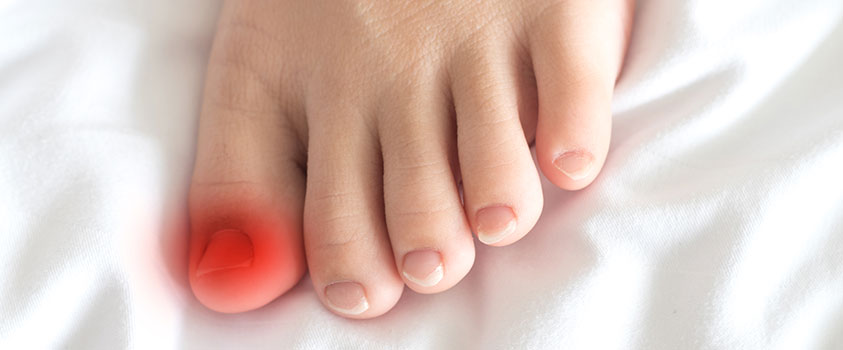
Ingrown toenails can be a real pain—literally! When the edge of your toenail starts growing into the surrounding skin, it can lead to significant discomfort, redness, swelling, and even pus-filled infections. This common problem can make everyday activities, like walking and sleeping, almost unbearable. Many people hide their toes, especially during the summer, out of embarrassment.
For more information about who is prone to developing ingrown toenails and ways to prevent them, visit our webpage.
The Vicious Cycle of Ingrown Toenails
A common scenario for those suffering from ingrown toenails involves a never-ending cycle: the toenail grows into the skin, causing pain. In an attempt to relieve the pressure, people often pick at or dig into the toe to snip off the extra nail, which can lead to infection. After a few weeks of relief, the nail grows back, and the cycle repeats. If this sounds familiar, it’s time to break the cycle. Start by soaking your foot in salty, lukewarm water for 10 minutes daily. This can soften the nail and reduce the chance of infection. However, seeing a podiatrist is crucial for proper treatment.
Should You Consider Surgery for an Ingrown Toenail?
Our experienced podiatrists have treated thousands of ingrown toenails. During your appointment, we will review your medical history, assess the affected nail, and recommend the best course of action. This might involve conservative treatments with regular podiatry appointments or, in some cases, surgery.
Although the term "surgery" might sound intimidating, the procedure is straightforward and performed in one of our clinic rooms. You can bring a friend for support and some music to help you relax. We take our time and explain each step of the process to ensure you are comfortable.
The Surgical Procedure
Anesthesia: We anesthetise your toe with a quick injection, ensuring you won’t feel anything during the procedure.
Cleaning: Your toe is cleaned with iodine.
Removal: We remove the problematic edge of your nail.
Chemical Application: A chemical is applied to kill a small section of the nail-growing cells, preventing that part of the nail from regrowing.
Dressing: Your toe is dressed to keep it clean, and you are ready to go home.
Aftercare Discussion: We will discuss aftercare instructions with you.
Aftercare Advice
Proper aftercare is crucial for a successful recovery. Here’s what you need to do:
Immediate Care: We will send you home with a large dressing on your toe, so bring flip-flops or sliders to wear after the appointment. Leave the dressing on for 24 hours and rest with your foot elevated for the first day.
Daily Care: For the next two weeks, soak your toe in a warm, saltwater bath for 10 minutes daily and then redress the area. We will show you how to do this.
Monitor for Infection: Watch for signs of infection such as redness, swelling, pus, or a foul smell. Contact us immediately if you notice any of these symptoms; you may need antibiotics.
Activity Restrictions: Refrain from playing sports and swimming for a few weeks. Once the wound has healed, you can resume normal activities.
Long-Term Benefits
Ingrown toenail surgery has a 95% success rate. This treatment can free you from the recurring pain and worry of infections, making it a worthwhile investment in your health and well-being.
Don’t let ingrown toenails control your life. Reach out to us so we can relieve your pain and restore your quality of life. With proper treatment and aftercare, you can return to enjoying your favorite activities without the constant worry of discomfort. We look forward to helping you!
5 seated chair exercises for seniors
As we age, maintaining an active lifestyle becomes increasingly important for our overall health and well-being. However, many seniors face challenges that make traditional forms of exercise difficult. That's where seated chair exercises come in.
These low-impact exercises are designed to help seniors stay fit and flexible without the need for strenuous activity or standing. In this blog, we will explore five simple and effective seated chair exercises that can easily be incorporated into your daily routine: the Overhead Bend and Reach, Shoulder Blade Squeeze, Knee Extension, Neck Rotation, and Marching in Place. Each of these exercises targets different muscle groups and promotes flexibility, strength, and circulation, all while being gentle on the joints.

Overhead Bend and Reach
- Raise both arms above your head.
- Lower your right arm and lean to the right. Feel the stretch on your left side.
- Hold for at least 15 seconds.
- Return to your original position with your arms over your head.
- Drop your left arm and lean to the left.
- Repeat 2 to 4 times toward each side.

Shoulder Blade squeeze
- Lift your arms near the level of your shoulders with your elbow pointed straight out.
- Bring your elbows back while you squeeze your shoulder blades together. Don’t lift or shrug your shoulders as you are squeezing.
- Hold for 6 seconds.
- Repeat 8 to 12 times.
Knee extension
- Straighten and lift one leg and hold while you count to 5. Be sure you don’t lock your knee.
- Slowly lower your leg down.
- Repeat 8 to 12 times.
- Repeat on the other leg.

Neck Rotation
- Turn your head to the left and hold for at least 15 seconds.
- Repeat on the right side.
- Repeat 2 to 4 times to each side.
Marching in Place
- Sit with your feet slightly apart and march in place, lifting your knees high toward the ceiling.
- Remember to breathe normally.
- Keep marching in a smooth rhythm for 1 minute.
- Work up to marching 5 minutes or longer.

Incorporating these five seated chair exercises into your daily routine can significantly enhance your physical health and overall well-being. Whether you want to improve your flexibility, strengthen your muscles, or boost your circulation, these exercises offer a safe and effective way to stay active. Remember, consistency is key—make these exercises a regular part of your day, and you'll soon notice the benefits.
Always consult with your healthcare provider before starting any new exercise regimen to ensure it's appropriate for your individual health needs. If you experience any discomfort in your leg, ankle or feet, get in touch. We are here to help.
Here's to staying active, healthy, and happy at any age!
Latest Tips
- Why Heel Pain Is So Common
- At FootScan appointment at Essex Footcare
- The Complete Guide to Footwear: Choosing the Right Shoes for Every Occasion
- How is Your Socks Life?
- What is Swift Microwave Therapy?
- Is your ingrown nail a right pain the foot ?
- Chair exercises
- Would You Like Your Toe Nails To Feel & Look Great?
- Do you have painful heels in the Morning?
- Do you suffer with any one of these 5 common foot conditions?
What People Say
-
Looking after my feet for 20 years
Sushila Patel has been looking after my feet for more than 20 years....
-
The shoes have made my life so much easier
I am extremely pleased with the kindness and service that I was...
